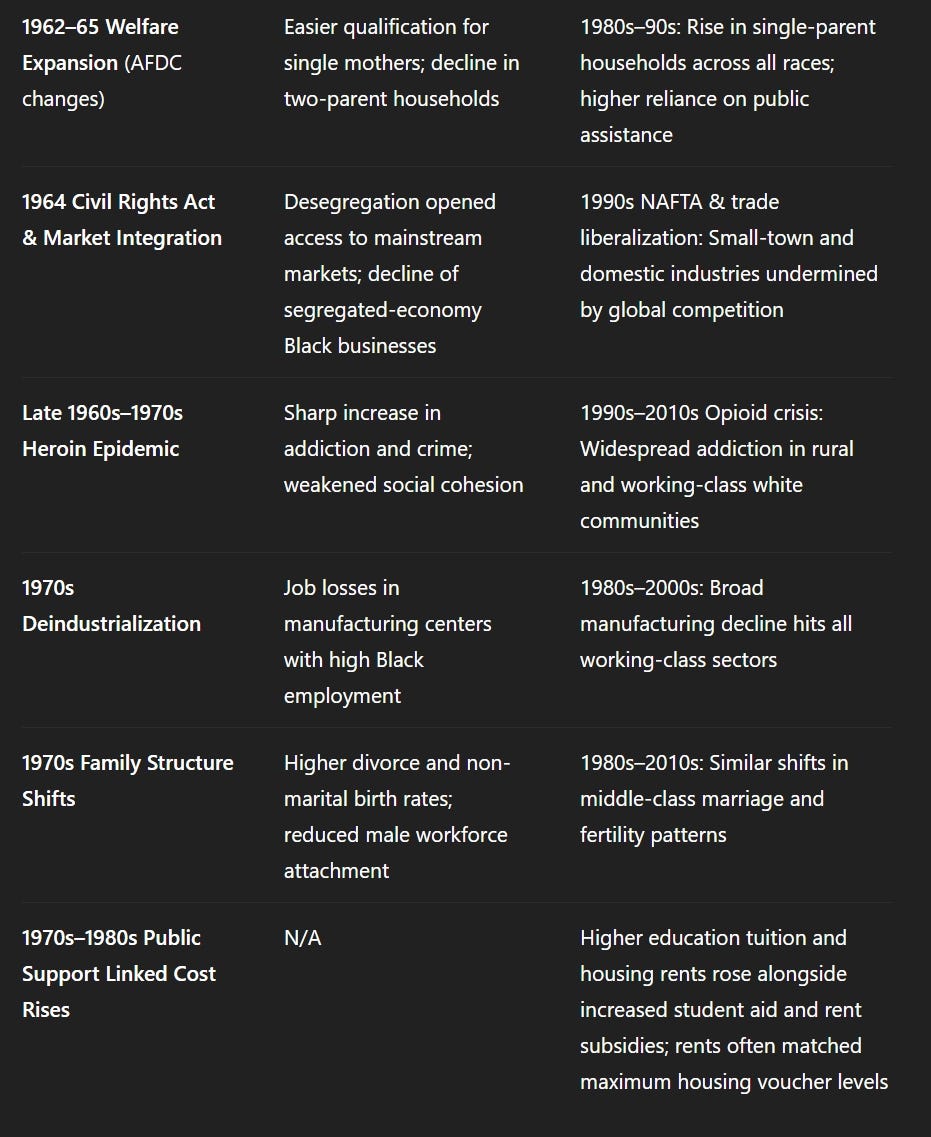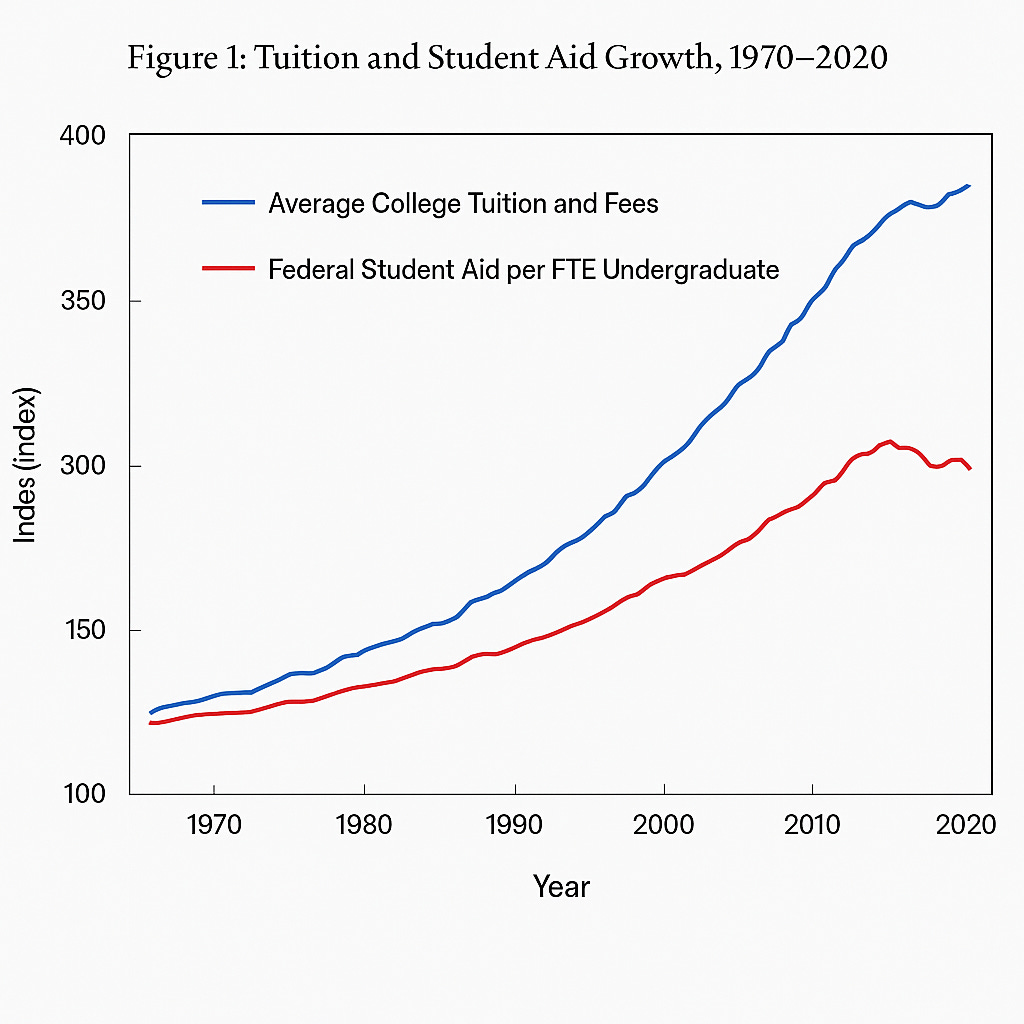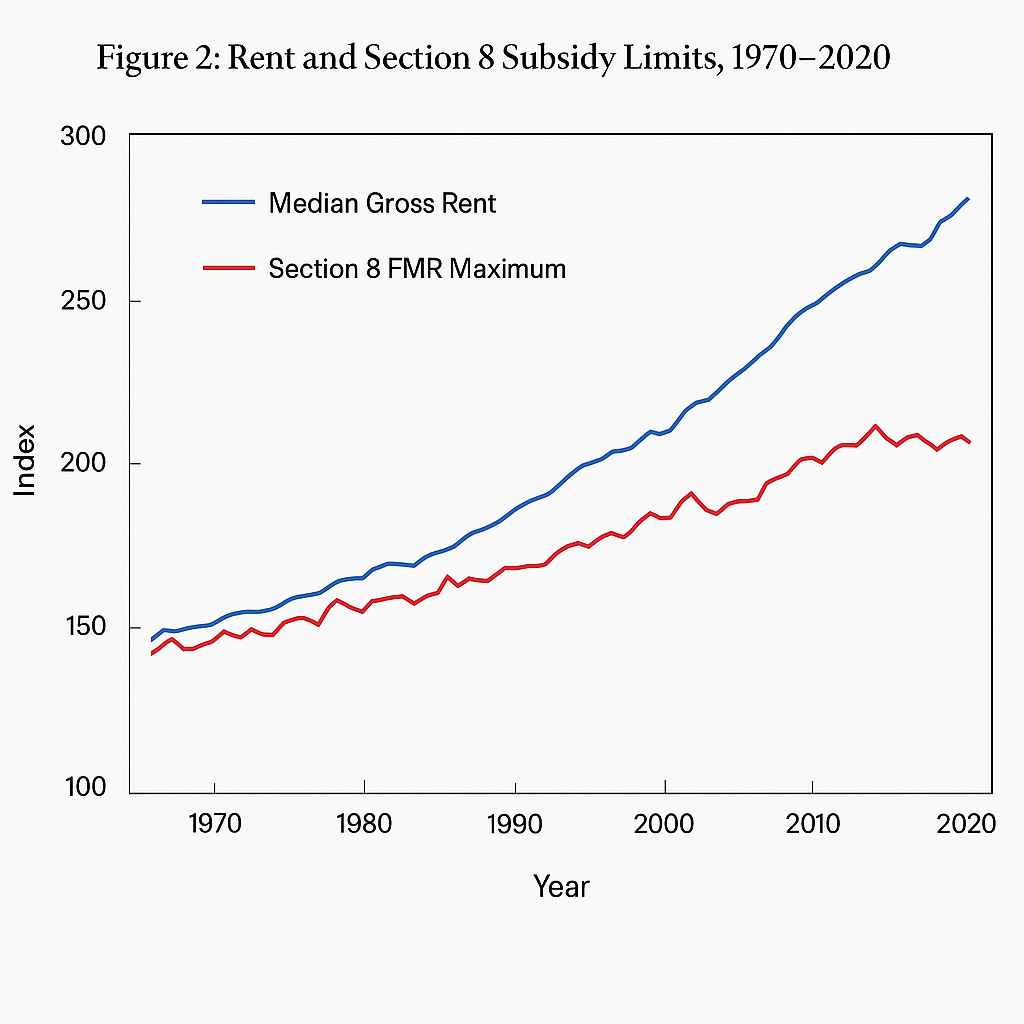Multiverse Journal - Index Number 2226:, 4th August 2025, Strong Black Communities were the Testbed in How to Destroy Middle-Class
Journal across Realities, Time, Space, Soul-States.
—
August 4th, 2025
Good Monday,
May the Spirit of the Gospel and the Holy Word be Always on our Tongues, in our Hearts, Minds, and in our Hands.
Holy Virgin Mother Mary and All Saints - Pray for us!
—
Index Number 2226:
— —
May this article find us all ever closer to God, and His Clarity.
After researching the post-1979 gov-corporation coordinated attack and destruction of the Significant Middle-Class, I published my results found below. I argue that if wages continued to raise with productivity our nation and people would be unbelievably better off, double median wages, lower taxes if return to corporate vs people ratio. UDI (Universal Dividend Income) of monthly Dividend Check of $3500 per legal citizen (and 1/3 amount per child) when including average Welfare spending.
I follow with this article that shows Black Community Welfare caused Fatherlessness, desegregation destroyed Black Businesses and Black unemployment, CIA shipping Heroine into InterCitys, all caused the collapse of the Once Strong Black Communities as a Testbed that was template used starting late 1970s, a decade later, to Undermind and destroy the large politically strong Middle-Class.
—
First: (Post-1970s attack on middle class while politically amplifying Corporate Political Power - “Money is Speech!”)
I've tracked down the information to argue that since 1979 Gov and corp have been silencing and impoverishing regular people. If Synagogue of Satan Zionist and other minions had left well enough alone, you would not believe how much better we all and our nation would have been. Listen for taste, read for truth.
AI generated audio overview of article;
URL: https://notebooklm.google.com/notebook/9fc1b713-4c44-49bd-9c29-04fc3fe09744/audio
Full article;
---
Second: (Detailed references that better support above article)
In the 2nd Proposal in following article more fully detail the attack on Middle-Class.
AI generated audio overview of 2nd proposal;
URL: https://notebooklm.google.com/notebook/2d142bfa-9f3e-439a-8fc0-696db7442db2/audio
Full article;
—
This section from the article “Black America Before LBJ: How the Welfare State Inadvertently Helped Ruin Black Communities” presents a single significant harm to Black communities that was latter directed at working-and-middle Class families, the entire Western societies, and beyond.
The Breakdown of the Black Family
“The black family, which had survived centuries of slavery and discrimination, began rapidly disintegrating in the liberal welfare state that subsidized unwed pregnancy and changed welfare from an emergency rescue to a way of life.”
The biggest problem resulting from the Great Society is the breakdown of the black family. This is a sensitive subject, but one that must be broached to fully understand the devastating impact that the Great Society has had on the black community in the United States.
In 1965, when the Great Society began in earnest following the massive electoral landslide reelection of LBJ, the out-of-wedlock birthrate among the black community was 21 percent. By 2017, this figure had risen to a whopping 77 percent. In some cities, this rate is as high as 80 percent, with most of the unwed mothers being teenagers. We have documented extensively in our article on the death of civil society in the United States the negative effects of the single-parent household on child development and outcomes. The black community is now entering its third generation of single parenthood as the norm, something that rose astronomically with the advent of the Great Society.
To provide some historical context, the out-of-wedlock birth rate in the black community was already rising before the Great Society. In 1938, that rate stood at 11 percent. Still, it’s worth noting the difference between the slow and steady increase of 1938 to 1965, and the explosive growth from 1965 until the present day. In any event, black women were more likely to be married than white women as late as 1950. It’s also worth looking at single parenthood over time: In the 1950s, 52 percent of all black children lived with both parents until the age of 17. By the 1980s, that number had plummeted to 6 percent.
In addition to outcomes, there is also a wide divide between the percentage of black families in poverty when there is a father present. Among married black families, the poverty rate is 8 percent. Among black households headed by a single mother, that rate jumps to 37 percent.
And again, while we outline a number of negative consequences resulting from single-parent families, it’s worth pulling one out in relation to the destruction of the black family in America: There is no better predictor of male criminality than being raised in a fatherless home. 70 percent of all juvenile offenders in state reform institutions were raised in fatherless homes. This includes 60 percent of all rapists, 72 percent of all murderers, and 70 percent of long-term inmates.
—
I hope that this Theory with the data inspires consideration and debates.
God Bless., Steven
AI generated audio outline of this Article;
URL: https://notebooklm.google.com/notebook/9fd4e4bd-18d8-48ed-8ea8-c151a483638e/audio
Title: Socioeconomic Parallels Between 1960s Black Community Disruption and Late-20th Century Middle-Class Decline
Abstract
This paper examines the hypothesis that social and economic disruptions first observed in Black American communities during the 1960s and 1970s parallel, in timing and structure, later trends affecting the broader American working and middle classes. Using a chronological, evidence-based framework, the study explores economic policy changes, social welfare shifts, legal reforms, drug epidemics, cost-of-living dynamics, and public-subsidy-related inflation as interconnected phenomena. While causality and intentionality remain debated, the parallels merit closer study.
1. Introduction
The mid-20th century witnessed major social and economic transformations in the United States. During the 1960s, Black urban communities experienced rapid negative changes in family structure, economic stability, and social cohesion. Decades later, similar patterns emerged in the broader working- and middle-class population. This paper evaluates these parallels using available historical and sociological evidence.
2. Background
Pre-1960s Black Communities: High rates of two-parent households; strong religious participation; vibrant local economies supported by Black-owned businesses; relatively high male labor force participation; very low incidence of children born out of wedlock.
1960s Policy Environment: Civil Rights legislation, War on Poverty programs, and urban renewal projects altered economic and social structures. Increasing Welfare availability damaged Black families and Black fatherlessness. Civil Rights Legislation removed Segregation that destroyed most Black owned businesses and their Black employees. CIA shipped South Asian heroin shipped into the resulting damaged Black Communities and created crime related employment, gang violence, and addiction.
Late 20th Century Shifts: Corporation and Federal Government attacked Middle-Class with Wage stagnation, deindustrialization, global trade liberalization, rising education and housing costs, and social policy reforms altered middle-class stability.
Details here:
3. Side-by-Side Timeline
4. Key Factors
Economic Policy Changes: Post-1973 stagflation and subsequent economic restructuring suppressed wage growth.
Trade Liberalization: NAFTA and other agreements accelerated job outsourcing.
Trade Liberalization and NAFTA’s Impact
NAFTA itself was primarily a trade agreement and did not explicitly create subsidies for U.S. companies to relocate abroad, but it operated alongside other federal policies in the 1990s that did provide tax advantages and cost support for such moves. The combination of NAFTA’s provisions and related policy changes made relocation financially attractive for many corporations.
Relocation Incentives:
Tax Deferrals on Foreign Earnings: U.S. multinationals could defer paying U.S. taxes on profits earned by foreign subsidiaries until those profits were repatriated, reducing the immediate tax burden of operating abroad.
Deductible Relocation Expenses: Companies could write off certain costs of closing domestic plants and moving operations overseas as ordinary business expenses.
Export Processing Zones & Maquiladora Program: Particularly in Mexico, these zones allowed for low-cost manufacturing near the border with reduced tariffs and favorable regulations.
Tariff Reductions & Market Access Guarantees: NAFTA’s elimination of tariffs made it cheaper to import goods back into the U.S. after manufacturing abroad.
State-Level Incentives: Some states offered additional tax credits or grants to companies building supply chain links with NAFTA partner facilities.
Documented Job Losses: Studies by the Economic Policy Institute and the U.S. Department of Labor show that from 1994 (NAFTA’s start) to 2010, the U.S. lost an estimated 700,000 to 1 million manufacturing jobs directly attributable to NAFTA-related offshoring. The heaviest losses were in the auto, electronics, apparel, and machinery sectors.
The hardest-hit states included Michigan, Ohio, Pennsylvania, and North Carolina.
Many lost jobs were in unionized plants that had provided stable middle-class wages and benefits.
Job losses triggered multiplier effects, causing further employment decline in supporting industries and local service economies.
These incentives, combined with NAFTA’s market access provisions, reduced the cost differential between domestic and foreign operations. This effectively subsidized relocation in practice, accelerating the offshoring of manufacturing jobs and contributing significantly to the erosion of the U.S. industrial base and middle-class employment.
NAFTA Gutted local, state, and federal tax income:
Legal Shifts: No-fault divorce laws increased household instability. This expanded the early to mid 1960s Welfare attack fatherhood, families, children born out of wedlock.
Drug Availability: Drug epidemics in both eras undermined community stability and increased crime. CIA shipping South Asian Herion into Black communities after family destroyed, high unemployment had significantly damaged those communities, as the middle-Class was attacked by corporate pharmacies Opiates after Corp-Gov wage-suppression, increasing taxes, NAFTA destroyed manufacturing employment and Union wages, No-Fault Divorce destroying fatherhood and secure families.
Cost Inflation Tied to Subsidies: College tuition growth often tracked increases in federal student aid; rent increases frequently aligned with maximum allowable housing subsidy levels.
5. Visual Data
Figure 1: Tuition vs. Federal Student Aid Growth (1970–2020)
Line chart showing parallel rises in average public university tuition and average per-student federal aid.
—
Figure 1a: Federal Student Aid by Program (Loans, Grants, Work-Study)
A stacked area chart illustrating proportional growth of federal loans, grants, and work-study funding per decade. Loans constitute the largest and fastest-growing portion of aid, grants have grown steadily, and work-study funding has remained relatively stable.
—
—
Figure 2: Rent Index vs. Section 8 Maximum Allowable Subsidy (1980–2020)
Line chart illustrating how median rents in many markets tracked closely with changes in the maximum voucher amount.
—
Incorporating Figures 1, 1a, and 2 into the broader analysis supports the view that public subsidies—whether for education or housing—can influence market pricing dynamics. In higher education, expanded aid correlates with steep tuition growth, and in housing, rent trends often track subsidy ceilings. The composition of federal student aid further reveals the growing dominance of loans over grants, increasing long-term debt burdens and potentially amplifying economic fragility.
These visuals highlight the possibility that public subsidies, while intended to improve access, also influences market pricing dynamics.
6. Discussion
While each factor seems to have independent causes, their combined clustering pattern resulting in damage of all most significant roots in historically strong Black communities during the 1960s and 1970s mirrors later and similar combined clustering pattern, damaging of all most significant roots in historically strong working- and middle-class populations.
The link between public subsidy growth and corresponding cost inflation in education and housing raises further questions about whether the seemingly well-intended programs further fueled affordability crises, general poverty, opportunities for socioeconomic advancement, loss of liberties, freedoms, and hope that education, hard-work, and skill can reward us with better lives for us and for the significantly smaller numbers of our children.
7. Conclusion
The historical record shows striking parallels between mid-century disruptions in Black communities and late-century destabilization of the broader middle class. The replication of social and economic breakdown patterns—combined with rising costs in education and housing alongside subsidy expansion—warrants further study as a matter of public policy and social history.
References
Moynihan, D.P. (1965). The Negro Family: The Case for National Action. U.S. Department of Labor.
Putnam, R.D. (2000). Bowling Alone: The Collapse and Revival of American Community. Simon & Schuster.
Wilson, W.J. (1987). The Truly Disadvantaged. University of Chicago Press.
McCoy, A.W. (1972). The Politics of Heroin in Southeast Asia. Harper & Row.
Sowell, T. (2011). Economic Facts and Fallacies. Basic Books.
Walker, J.E.K. (1998). The History of Black Business in America. Macmillan Library Reference.










